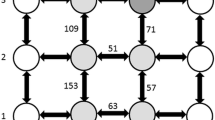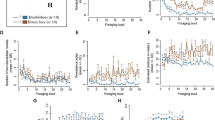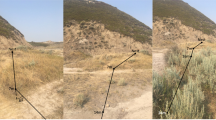Abstract
Ants (Formicidae) perform two distinct search behaviors for resources: on the ground they use irregular, almost random alternating looping, and on branches and leaves they resort to outline-tracing (arboreal systematic search), whereby the individual systematically turns to one side at bifurcations and to the opposite side when turning about at end points. Experiments with searching Formica pallidefulva and Crematogaster cerasion artificial stick mazes under seminatural conditions demonstrated that bifurcations and end points only trigger turn decisions, whereas an intrinsic mechanism specifies the handedness of such turns. Arboreal homing differs from arboreal searching by a much stronger tendency to rectify paths by counterturning. The theory is advanced that searching on branches by outline-tracing is evolutionarily derived from ranging search by superposing a sustained intrinsic turn bias and by suppressing random turns.
Similar content being viewed by others
References
Bammer, G., Barnett, S. T., and Marples, T. G. (1987). Movement patterns of wild house mice in na four-arm residential maze.Psychol. Rec. 37: 545–551.
Bell, W. (1985). Sources of information controlling motor patterns in arthropod local search orientation.J. Insect Physiol. 31: 837–847.
Bovet, P. (1979). La valeur adaptive des comportemonts aleatoires.Ann. Psychol. 79: 505–525.
Bovet, P., and Benhamou, S. (1988). Spatial analysis of animals' movements using a correlated random walk model.J. Theor. Biol. 131: 419–433.
Brown, M. F., and Cook, R. G. (1986). Within-trial dynamics of radial arm maze performance in rats.Learn. Motiv. 17: 190–205.
Burger, M.-L. (1971). Zum Mechanismus der Gegenwendung nach mechanisch aufgezwungener Richtungsanderung beiSchizophyllum sabulosum (Julidae, Diplopoda).Z. vergl. Physiol. 71: 219–254.
Cammaerts, R., and Cammaerts, M. C. (1987). Nest topology, nestmate recognition, territorial marking and homing in the antManica rubida. (Hymenoptera, Formicidae) Biol.Behaviour 12: 65–81.
Daanje, A. (1957). Die Blattrolltechnik vonApoderus coryli L. undAttelabus nitens Scop. (Coleoptera, Attelabinae).Behaviour 11: 85–155.
Dingle, H. (1962). The occurrence of correcting behavior in various insects.Ecology 43: 727–728.
DuBois, M. B. (1986). Distribution of ants in Kansas: Subfamilies Ponerinae, Ecitoninae, and Myrmicinae (Hymenoptera: Formicidae).Sociobiology 11: 153–188.
Görner, P. (1973). Beispiele einer Orientierung ohne richtende Aussenreize.Fortschr. Zool. 21: 20–45.
Harkness, R. D., and Maraudas, N. G. (1985). Central place foraging by an ant (Cataglyphis bicolor Fab.): A model of searching.Anim. Behav. 33: 916–928.
Hoffmann, G. (1983a). The random elements in the systematic search behavior of the desert isopodHemilepistus reaumuri.Behav. Ecol. Sociobiol. 13: 81–92.
Hoffman, G. (1983b). The search behavior of the desert isopodHemilepistus reaumuri as compared with systematic search.Behav. Ecol. Sociobiol. 13: 93–106.
Hölldobler, B., and Taylor, R. W. (1983). A behavioral study of the primitive antNothomyrmecia macrops Clark.Insectes Soc. 30: 384–401.
Jaffe, K., and Howse, P. E. (1979). The mass recruitment system of the leafcuttingant Atta cephalotes.Anim. Behav. 29: 930–939.
Jander, R. (1957). Die optische Richtungsorientierung der Roten Waldameise (Formica rufa L.).Z. vergl. Physiol. 40: 162–238.
Jander, R. (1963). Grundleistungen der Licht- und Schwereorientierung von Insekten.Z. vergl. Physiol. 47: 381–430.
Jander, R. (1975). Ecological aspects of animal orientation.Annu. Rev. Ecol. Syst. 6: 171–188.
Jander, R. (1977). Orientation ecology. InGrzimeks's Encyclopedia of Ethology, Van Nostrand Reinhold, New York, pp. 145–163.
Jander, R., and Daumer, K. (1974). Guide-line orientation and gravity orientation of blind termites foraging in the open (Termitidae,Macrotermes, Hospitalitermes).Insectes Soc. 21: 45–69.
Klotz, J. H., Cole, S. L., and Kuhns, H. R. (1985). Crest-line orientation inCamponotus pennsylvanicus (Degeer).Insectes Soc. 32: 305–312.
Linsenmair-Ziegler, C. (1970). Vergleichende Untersuchungen zum photogeotaktischen Winkeltransponieren pterygoter Insekten.Z. vergl. Physiol. 68: 229–262.
Mittelstaedt, M. L., Mittelstaedt, H., and Mohren, W. (1979). Interaction of gravity and idiothetic course control in millipedes.J. Comp. Physiol. 133: 267–281.
Sabelis, M., and Dicke, M. (1985). Long-range dispersal and searching behaviour. In Helle, W., and Sabelis, M. W. (eds.),Spider Mites. Their Biology, Natural Enemies and Control, Vol. 1B, Elsevier, Amsterdam, pp. 141–160.
Santschi, F. (1913). Comment s'orient les fourmis.Rev. Suisse Zool. 21: 347–426.
Schäfer, M. (1975). Gegendrehung und Winkelsinn in der Orientierung vonLithobius forficatus L.Behaviour 55: 15–72.
Schäfer, M. W. (1982). Gegendrehung und Winkelsinn in der Orientierung verschiedener Arthropoden.Zool. Jb. Physiol. 86: 1–16.
Taylor, R. W. (1978).Nothomyrmecia macrops: A living-fossil ant rediscovered.Science 201: 979–985.
Visser, J. H. (1988). Host-plant finding by insects: Orientation, sensory input and search patterns.J. Insect Physiol. 34: 259–268.
Walker, J. (1986). Methods for going through a maze without becoming lost or confused.Sci. Am. 255(Dec.): 140–147.
Wehner, R., and Srinivasan, M. V. (1981). Searching behaviour of desert ants,Cataglyphis bicolor (Hymenoptera: Formicidae)J. Comp. Physiol.142: 315–338.
Wendler, G. (1975). Physiology and systems analysis of gravity orientation in two insect species (Carausius morosus, Calandra granaria).Fortschr. Zool. 23: 33–48.
Wilson, E. O. (1971).The Insect Societies, Harvard University Press, Cambridge, Mass.
Author information
Authors and Affiliations
Rights and permissions
About this article
Cite this article
Jander, R. Arboreal search in ants: Search on branches (Hymenoptera: Formicidae). J Insect Behav 3, 515–527 (1990). https://doi.org/10.1007/BF01052015
Accepted:
Issue Date:
DOI: https://doi.org/10.1007/BF01052015




